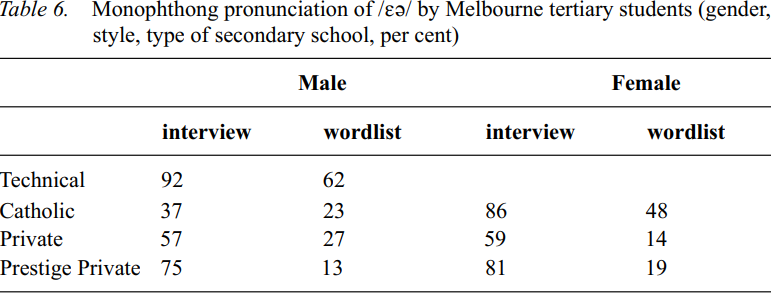


 Grammar
Grammar
 Tenses
Tenses
 Present
Present
 Past
Past
 Future
Future
 Parts Of Speech
Parts Of Speech
 Nouns
Nouns
 Verbs
Verbs
 Adverbs
Adverbs
 Adjectives
Adjectives
 Pronouns
Pronouns
 Pre Position
Pre Position
 Preposition by function
Preposition by function 
 Preposition by construction
Preposition by construction
 Conjunctions
Conjunctions
 Interjections
Interjections
 Grammar Rules
Grammar Rules
 Linguistics
Linguistics
 Semantics
Semantics
 Pragmatics
Pragmatics
 Reading Comprehension
Reading Comprehension|
Read More
Date: 2023-09-01
Date: 2024-05-02
Date: 2024-06-05
|
There is considerable variation in the presence and prominence of offglides in the formerly mainly rhotic word classes NEAR, CURE, SQUARE, CLOTH. The main regional characteristic here is the very frequent presence of long monophthongal forms for NEAR and CURE vowels in Sydney. Monophthongs are very much less frequent elsewhere other than preconsonantally within a word as in years or toured. In addition, they are prevalent when prelateral in certain frequently-occurring polysyllabic words such as really. Monophthongs for NEAR in Melbourne range from three to 18 per cent of tokens overall, showing strong social and smaller gender and stylistic differences: working class speakers, males and casual style use more monophthongisation. Monophthongs represent 0 to 17 per cent of final and 10 to 35 per cent of preconsonantal NEAR tokens, again with a strong social difference, but also a substantial gender and style difference.
Monophthongal forms of SQUARE and CLOTH words are by contrast extremely frequent throughout Australia, with environmental constraints; a following consonant within the word favors a monophthong, parallel to NEAR and CURE. Conversely, strong stress and final position permit a virtually disyllabic realization, [ɪjз] for NEAR, [(j)ʊwз] for CURE, [εjз] for SQUARE, and [ɔwз] for CLOTH words without final consonant such as paw or pore (or for that matter poor; in Australian English many CURE words without a preceding /j/ glide have merged into the CLOTH class, and even those with the glide also vary between [jʊwз] and [jɔ] realizations). Table 6 (Bradley and Bradley 1979: 78) shows the pattern of monophthongisation for the NEAR vowel in Melbourne among tertiary-age students, favoring the offglide in isolation and also showing differences between speakers based on the type of secondary school attended, reflecting social differences. In the sample, there were no female students who had attended technical secondary schools.

|
|
|
|
التوتر والسرطان.. علماء يحذرون من "صلة خطيرة"
|
|
|
|
|
|
|
مرآة السيارة: مدى دقة عكسها للصورة الصحيحة
|
|
|
|
|
|
|
عقد جلسة حوارية عن ضحايا جرائم التطرف ضمن فعاليات اليوم الثاني لمؤتمر ذاكرة الألم
|
|
|